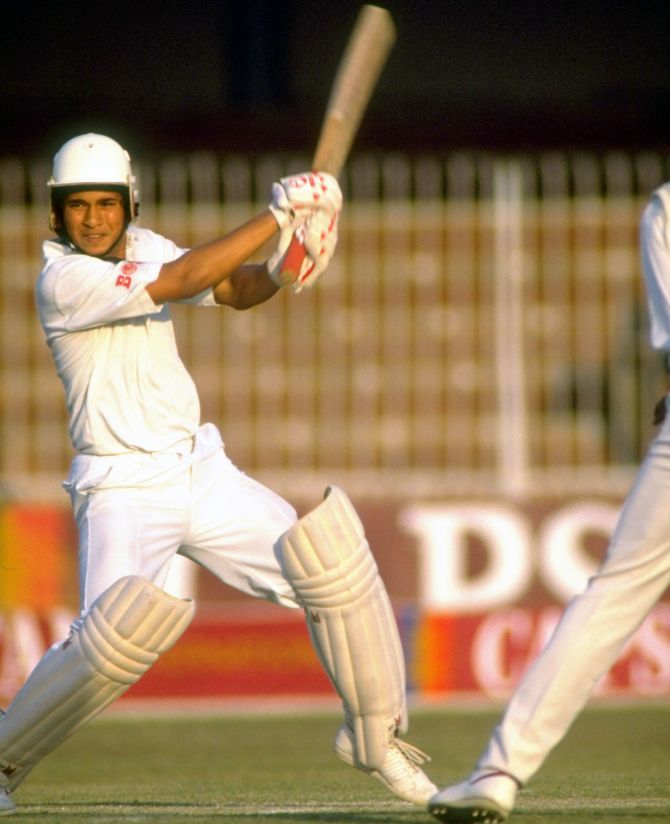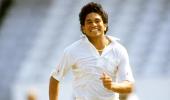'When you looked at him even at that age, you could make out he was special.'

Kiran More proudly remembers his world record effort against the West Indies in the Chennai Test in 1988.
More effected six stumpings in that Test, including five in the second innings, a record which still stands after 32 years.
That game may be remembered for Narendra Hirwani's sensational debut when he claimed 16 wickets -- including eight in each innings -- but his achievement was only due to More's brilliance with the gloves behind the stumps.
"Sachin was a kid in the dressing room. He kept us entertained always. He used to imitate the bowling action of Imran, Waqar and Qadir," Kiran More tells Rediff.com's Harish Kotian.
- Part 1: 'Dhoni is very smart'
- Part 2: 'Dropping Ganguly was not easy'
- Part 3: 'In the evening, our dressing room was like a hospital'
You had to wait nearly three years before you made your Test debut at Lord's in June 1986, a match which India won by five wickets.
You scored a crucial 25 runs at No 10 and took five catches in the match as India won the match by five wickets.
Was that a relief to finally get a chance to make your Test debut after waiting for so long on the bench?
I was the No 1 wicket-keeper for India on that tour of England.
Playing your first Test match is always special, especially if you have waited for so long. I got into the Indian team in 1983, but I made my debut only in 1986, so I had to wait for three years to play my first Test.
But those three years were very helpful for me. I learnt a lot, I had a good idea about the Test match environment.
I was used to the bowlers after so many net sessions, I knew what they would bowl.
I had played a lot of side games and I had also played many ODIs for India, so I was well equipped for Test cricket by that stage.
It was really special to make my Test debut at Lord's. I felt a lot of pressure on the first day because the whole world is watching when it is your first day.
I remember ahead of the first day, the maharaja of Baroda, Fateh Singh Rao Gaekwad, had come to the dressing room to congratulate me and wish me luck.
I grabbed the opportunity with both hands at Lord's with five dismissals and my knock of 25 was crucial because I had a good partnership with Dilip Vengsarkar.
What made my debut special was that we went on to win the Test, and that was India's first Test win at Lord's.
I was very happy with my performance because I did well with the bat and also with the gloves.
That whole series in England went to plan for me and the icing on the cake was that India won the series 2-0.
I got 16 dismissals in that series and I also did quite well with the bat, so I was very satisfied.
Even today, that series win is rated quite highly because overseas series wins in places like England are not easy.
And that series win was important for me because if we had lost that series then people would have questioned my inclusion.
Your world record of six stumpings in a Test and five in an innings against the West Indies in Chennai in 1988 still stands after 32 years.
That wicket was a turning track, it was not a patta (flat) wicket. The ball was turning from the first day itself.
You should not take away any credit from Narendra Hirwani who picked up so many wickets in his debut match.
Arshad Ayub was bowling from one end, Hirwani was bowling from the other end. You also had other spinners like Ajay Sharma, W V Raman and even Ravi Shastri.
They were all getting the ball to turn, but only Hirwani got wickets in that match, eight wickets in both innings.
The other spinners bowled a lot of overs too, but they were not as successful as Hirwani who had something special about him.
He got the ball to turn big, he had a nice googly, he could get the ball to go straight through, he was slow in the air. The West Indies tried to hit him out of the park, they were too aggressive against him.
After he took eight wickets in the first innings, the West Indies batsmen again decided to try the same tactics by trying to hit him, but again he came on top.
They were all stepping out to hit him, but Hirwani bowled a good line and length and he had great control.
Was it difficult for to keep wickets when the ball is turning so much?
On turning tracks, the wicket-keeper is always in the game.
I always believed that it is easy to keep wickets on turning tracks.
It is difficult for sure, but not that difficult because on such wickets, the ball is coming to you all the time.
I would say it is difficult to keep wickets on flat wickets, because every half hour or one hour, one ball will come. So that is very difficult to keep wickets.
On turning wickets or seaming wickets, if it has good bounce, then you will enjoy wickets. But on flat wickets, where you see more than 500 runs being scored, it is difficult to keep wickets, it is hard to concentrate.
On turning tracks, even if you miss once, then another chance could come after three or four deliveries, because the ball turns so much.
Hirwani bowled those big turning leggies or googlies and all the West Indies batsmen tried to charge down the track. They missed and were stumped. They had no clue on how to pick Hirwani, so he got 16 wickets.
I had no idea that I created a world record. It was only the next morning when I saw in the newspaper that I realised about the world record.

You were rated as one of the best wicket-keepers against spin. Did you read the spinners from the hand or from the pitch?
There are two ways to read the spin bowler. A lot of bowlers bowl with their body action and you can make out from their action from where the hand is coming from or from the fingers as to which way the ball is going to turn or which ball will go straight through or whether it is a googly.
And from the ball also, from the seam you can make out in the air which way it will turn.
I had a pretty good idea about Hirwani. Actually, I never asked any bowler in my career when he is going to bowl which delivery, but I always picked all the spinners very well.
You can say I had that god gift. I could always pick all the spinners and their variations very well.
I kept against the spinners in the nets so I had a good idea about what deliveries they were going to bowl.
I used to practice a lot before any tour, and I also picked up their bowling when I played against them in domestic cricket.
Your unbeaten 58 at No 10 was crucial in helping India avoid the follow-on in the Karachi Test against Pakistan in November 1989 and the match finished in a draw after India made a good comeback with the second innings.
What was it like batting against Imran Khan, Waqar Younis and Wasim Akram?
We were struggling in that match because our batsmen didn't score much. They had scored 400-plus in their first innings. In reply, we were about 73/5 when Sachin Tendulkar got out. Mohammad Azharuddin also fell soon after.
Then me, Kapil Dev and Shastri put on some runs at the end. Spending time at the wicket was more important than runs.
Pakistan had a top class bowling attack -- Imran, Wasim and Waqar with Abdul Qadir as the spinner. So when you win or save the match against such quality opposition, then it gives you a lot of satisfaction, especially away from home.
Wasim and Waqar were young and they bowled really quick. Those days, teams used to scratch the surface of the ball or the seam to get the ball to reverse swing. It was not only in their team. Our bowlers did the same because we learnt from them in that series about those tactics.
That knock was very important for me because I was playing against Pakistan, and that too in their backyard. That was one of my best knocks because it helped to save the Test, after we avoided the follow-on.
In the second innings, we batted brilliantly, Sanjay Manjrekar scored a century, Navjot Singh Sidhu made 85, and the others also scored runs, so we drew the match.
That was a good tour for us. We drew the Test series in Pakistan. We had a young team, but we did really well. We had a lot of youngsters. Sachin was picked for the first time. We had Manjrekar, Vivek Razdan, Salil Ankola, we had so many new players.
It was an inexperienced team, but we still did well against a good Pakistan team.
The two young kids -- Manjrekar and Tendulkar -- batted really well. That was an important tour for me and I was happy to have done well.
Those days, when you didn't do well against Pakistan, you were dropped. The pressure from fans is huge and the media also focusses on you if you fail against Pakistan.
That draw in the four Test series in Pakistan was like a victory for us.
That was the first time Sachin Tendulkar was picked to play for India at 16. What do you remember of that young boy from that tour?
I had met Sachin before that tour. Around a year back, he had come to Baroda for a Ranji Trophy match with the Mumbai team. I had invited Chandrakant Pandit for lunch, he told me that he was bringing Sachin along.
So that was the first time I met. He was a very small kid then. And within a year of that meeting, he was with me on the tour of Pakistan.
Everyone was amazed by Sachin on that tour because he was so young, just 16 years old. But he had a great cricketing brain, like someone who is very experienced.
His reading of the game was superb even so early in his career, he was mentally very strong.
No doubt he had a lot of talent, but he also used to work hard in practice.
It was like Sachin was only made to play cricket.
When you looked at him even at that age, you could make out he was special.
He was a kid in the dressing room. He kept us entertained always. He used to imitate the bowling action of Imran, Waqar and Qadir.
He used to keep himself busy always, he could see him playing with the tennis ball in the dressing room because in Pakistan the dressing rooms were huge.
When I look back, I think of the time when Sachin played for the first time for India and I was in the team.
I also look back at the time I played with other greats like (Sunil) Gavaskar, (Srinivas) Venkataraghavan, Kapil, Mohinder Amarnath and others. They were legends.











